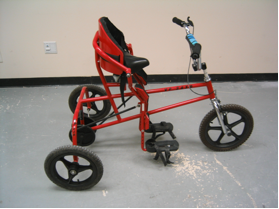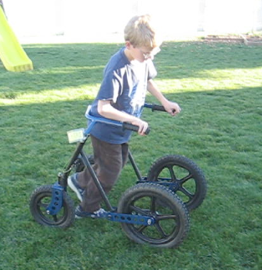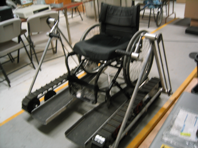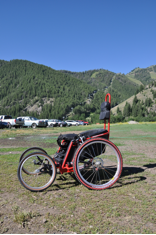[Editor's Note: This article is reprinted from of The Ergonomics Report™ archives (over 600 articles), Ergoweb's popular subscription news and resource service. Subscribers have had access to this article sine it was first published on May 9, 2012. Stay up-to-date with the evolving world of ergonomics and gain access to over 10 years of archives, subscribe to The Ergonomics Report™ today.]
Ergonomics is often defined as quantifying and improving the “fit” between the human and the system, often in the workplace, and generally considering the industrial worker as the population of interest, with a goal of reducing the potential for musculoskeletal disorders. Ergonomics research and development in the Mechanical Engineering Ergonomics and Biomechanics Lab at the University of Utah also includes non-occupational activities and non-standard user populations. In addition, the goal of this research and development is to facilitate rehabilitation, increase user mobility, and generally enhance the lives of users with disabilities.
The Ergonomics Program at the University of Utah is a part of the Rocky Mountain Center for Occupational and Environmental Health (RMCOEH), an Education and Research Center supported partially by the National Institute for Occupational Safety and Health (NIOSH). The lab was founded in 1986 and is funded primarily to address occupational safety and biomechanical hazards in the workplace. Over the years, however, we have become known for helping people with disabilities from both a therapeutic and recreational standpoint. Several of our inventions have received local and national publicity but our reputation has mostly grown by word of mouth between parents and caregivers. It is fortunate that at the University of Utah the Ergonomics Program is located in the Department of Mechanical Engineering. This means that ergonomists who have an understanding of how humans and systems interact, are teamed with mechanical engineers who know how to build things.
Our first device, developed several years ago, started with a call from Judy Gooch, a university hospital physician who worked with children with disabilities. Judy wanted to know if we could invent a system to help children with cerebral palsy (CP) exercise their gluteus muscles, which are important in walking. She noted that the existing method involved the children simply pulling their leg backward against the force of a bungee cord attached to a table leg – not much fun – and indicated that the kids got tired of it in minutes (who wouldn’t!). She wondered if we could come up with a way for the kids to exercise and have fun at the same time, which would make it easier to convince the kids to do it. After one iteration we came up with the idea of the trike, shown below, where the kids basically stand on the pedals and simulate walking – fun for the kids while also strengthening some of the same basic muscles as used in walking. One interesting outcome of this first project was the feedback from the parents that, while their child’s walking pattern improved, they were even more excited that their children were an active part of the neighborhood play activities – an unexpected (for us), but very satisfying, result.

This first project was the springboard for several other smaller scale projects for individual users. One, an off-road walker shown below, was developed at the request of an outdoor-oriented Utah family who enjoyed hiking and camping. Their son had CP but had difficulty moving over rough terrain in his walker. The device incorporates pneumatic tires and unique “rotary” suspension on the large wheels to successfully allow travel in rough areas. It continues to be used by the family.

On the other end of the user age “spectrum” we have also developed several systems devices that have the potential to enhance the lives of adults with disabilities. Senior citizens often use their quadraceps muscles to extend their legs and move their wheelchair backwards. While this does facilitate movement, the user can’t see the direction of travel and may collide with others. In a nursing home this can be disastrous. Several different wheelshairs were developed that allow the user to use the same leg extension but move the wheelchair forward. The most successful, shown below, is called the “trackball” design and allows the user to move in any direction by rotating the ball with their feet.

Several other wheelchairs have been designed and fabricated that allow alternative means of propulsion. One is a tracked wheelchair carriage, which allow users to roll their wheelchair up and secure it onto the carriage and, by turning a crank, go over sand, snow or other rough terrain. A second is an arm/lever propelled wheelchair that is even more maneuverable than a traditional wheelchair. The hand-propelled wheelchair allows the user to move the wheelchair forward by rotating the wrist (causing the calipers to grip the disc attached to the wheel) and pushing the arms forward. This allows easy forward and backward movement and proportional braking. Both of these wheelchairs are shown below.


The most recent effort, still under continued development, is the design and fabrication of paragliders for persons with disabilities: This project was accomplished in conjunction with the United States Hang Gliding and Paragliding Association, and AblePilot, a non-profit organization dedicated to making paragliding available as a recreational and therapeutic activity for persons with disabilities, specifically those with spinal cord injuries. These systems (the Phoenix I and Phoenix 1.5) were developed to allow persons with disabilities to be taken aloft as passengers and also to allow persons with disabilities to be trained and qualified to use the device as solo pilots. These systems, shown below, were designed to provide adequate torso support for persons with spinal cord injuries and with independent suspension systems to reduce the impact loading on landing.


The Phoenix 1 and 1.5 were initially used in a pilot program to train five injured military veterans in Sun Valley, Idaho, in summer of 2011. This training continued in Santa Barbara, California, early in 2012 in conjunction with Eagle Paragliding and in April 2012 two of these vets soloed and will soon be certified paraglider pilots. The Phoenix 2.0 is under development and hopefully will be the model for a system that can be used throughout the world.
It should be emphasized that the success of the design and development effort in the Ergonomic and Biomechanics Lab at the University of Utah is primarily due to the extraordinary capabilities of the mechanical engineering students. Many students also work as engineering technicians or interns at local industries and have amazing theoretical and practical skills. All of the devices illustrated above were designed and fabricated by these great students.
Donald Bloswick, Ph.D., P.E., CPE, is a professor in the Mechanical Engineering Department at the University of Utah, in Salt Lake City Utah. He is one of the founders of Ergoweb, and led the project during its start-up phase at the University of Utah in the early to mid 1990s.
